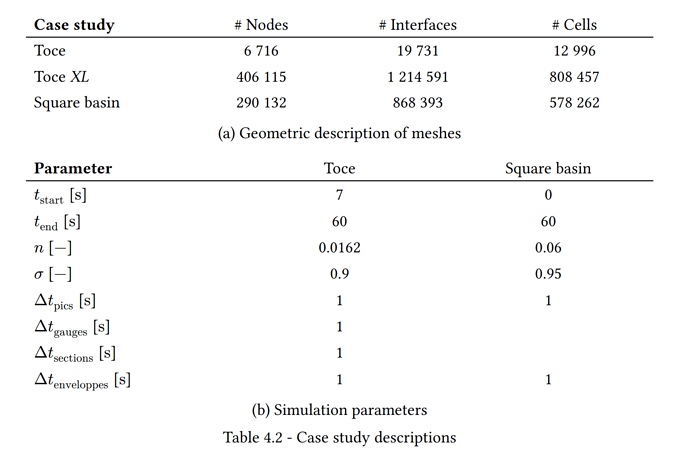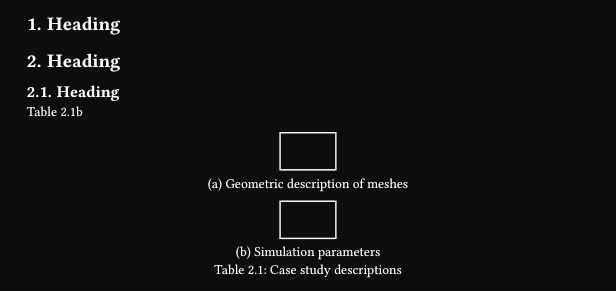Hi everyone,
In my document, I use multiple times subpar to handle subfigures as follows:
#import "@preview/subpar:0.2.2"
#import "@preview/fancy-units:0.1.1": num, unit, qty, fancy-units-configure, add-macros
#subpar.grid(placement:auto,
figure(
table(
columns: (1fr, 1fr, 1fr, 1fr),
table.header(
[Case study],
[\# Nodes],
[\# Interfaces],
[\# Cells]
),
[Toce], [6 716], [19 731], [12 996],
[Toce _XL_], [406 115], [1 214 591], [808 457],
[Square basin], [290 132], [868 393], [578 262],
) ,
gap: .75em,
caption: [
Geometric description of meshes
],
), <meshes>,
figure(
table(
columns: (1fr, 1fr, 1fr),
table.header(
[Parameter],
[Toce],
[Square basin],
),
[$t_"start"$ [#unit[s]]], [7], [0],
[$t_"end"$ [#unit[s]]], [60], [60],
[$n$ [#unit[-]]], [0.0162], [0.06],
[$sigma$ [#unit[-]]], [0.9], [0.95],
[$Delta t_"pics"$ [#unit[s]]], [1], [1],
[$Delta t_"gauges"$ [#unit[s]]], [1], [],
[$Delta t_"sections"$ [#unit[s]]], [1], [],
[$Delta t_"enveloppes"$ [#unit[s]]], [1], [1]
),
gap: .75em,
caption: [
Simulation parameters
]), <simulations>,
columns: 1,
caption: [Case study descriptions],
kind: table,
numbering: n => {
let h1 = counter(heading).get().first()
numbering("1.1", h1, n)
}, gap: 1em
)
as you can see I use custom numbering that aligns with headings. However, when referenced in the document, I got:

it does not respect the numbering. I tried to follow the procedure of Why do references to subfigures (using subpar) not respect custom numbering? but it didn’t work.
Is there a way to correct references ? And is there a way to set a rule such that my numbering is applied to all subpar figures without having to manually specify it ?
Thank you very much

